Thursday, February 24, 2005
Virtual Yellowbird
The virtues and pitfalls of PC based flight simulators for student and certified pilots have long been debated, and I won't attempt to contribute much to the arguments except to say that I have found them to be useful in preparation and familiarization even though they cannot replicate the very real physical sensations of actually controlling an airplane. Before I ever set foot in a small plane to begin flight training, I had tinkered around with Microsoft's Flight Simulator, even to the point of completing the basic flight lessons up to and including solo flight. When I started training for real, I found that my simulator time had given me a good basic foundation of understanding as to the workings of an airplane, and that gave me a bit of a head start, particularly in the book learning to prepare for the FAA written test. As I continued my training, I used Flight Simulator to practice procedures and to rehearse each of my cross country flights. I even went so far as to modify the default scenery for Barnes Municipal Airport to more accurately depict the environment I was training in.
 After I earned my license, and as I found my heart yearning for a Cardinal, I found that a very nice payware simulator model had been created by DreamFleet, one of the premiere producers of aftermarket accessories for the Microsoft Flight Simulators. Their Cardinal is considered to be one of the best general aviation aircraft simulator models produced to date, and at $22.95, it's much easier on the budget than a real 177. It is, in fact, two aircraft in one package for you get a 177B and a turbo 177RG, both modeled to the same exacting level of detail. The basic model is based on an actual 1978 177B that is operated by a Tennessee flying club, and the details include such personal touches as a tattered warning placard on the panel and a cell phone and sectional chart on the right seat. The model abounds with working features, including doors that open, clickable switches in the virtual cockpit, and operating landing gear for the RG. Even the glovebox can be opened, revealing a POH and other miscellaneous documents inside. Almost everything that can be operated on a real Cardinal is represented, with only the cabin ventilation and circuit breakers being static. Two handy utilities come with the package: Text-o-Matic allows for easy importation of repaint textures, and Config-o-Matic lets you change default settings for passenger and baggage weights, and switch between three different avionics suites with a click of the mouse, something the real-world aircraft manufacturers could do well to implement.
After I earned my license, and as I found my heart yearning for a Cardinal, I found that a very nice payware simulator model had been created by DreamFleet, one of the premiere producers of aftermarket accessories for the Microsoft Flight Simulators. Their Cardinal is considered to be one of the best general aviation aircraft simulator models produced to date, and at $22.95, it's much easier on the budget than a real 177. It is, in fact, two aircraft in one package for you get a 177B and a turbo 177RG, both modeled to the same exacting level of detail. The basic model is based on an actual 1978 177B that is operated by a Tennessee flying club, and the details include such personal touches as a tattered warning placard on the panel and a cell phone and sectional chart on the right seat. The model abounds with working features, including doors that open, clickable switches in the virtual cockpit, and operating landing gear for the RG. Even the glovebox can be opened, revealing a POH and other miscellaneous documents inside. Almost everything that can be operated on a real Cardinal is represented, with only the cabin ventilation and circuit breakers being static. Two handy utilities come with the package: Text-o-Matic allows for easy importation of repaint textures, and Config-o-Matic lets you change default settings for passenger and baggage weights, and switch between three different avionics suites with a click of the mouse, something the real-world aircraft manufacturers could do well to implement.
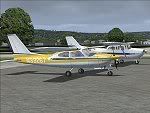 The model does have it's faults but some of these are typical of the way Microsoft recreates flight in the computer environment. The flight dynamics are probably as accurate as they can be, given the limitations of the medium, but I've found that the power settings don't always match real life experience (But how many real life airplanes follow the book performance numbers faithfully?) The sounds are recorded from the real Cardinal, but the balance between some of the sounds is clunky - the turn coordinator gyro in particular is very loud, even louder than the engine. The engine sound itself doesn't blend well throughout the RPM range, and the acoustic modeling of the constant speed propeller suffers from the same shortcoming that plagues all the other Microsoft aircraft that are so equipped - namely that the pitch of the engine sound follows the throttle setting instead of the propeller control when operating in the governed RPM range. Externally, it looks every bit a Cardinal, although the nose looks blunt and the tailcone may be shorter than it should be. Still, it captures the lines of the Cardinal pretty well, and it looks appropriately sleek, particularly when parked next to the default Skyhawk and Skylane.
The model does have it's faults but some of these are typical of the way Microsoft recreates flight in the computer environment. The flight dynamics are probably as accurate as they can be, given the limitations of the medium, but I've found that the power settings don't always match real life experience (But how many real life airplanes follow the book performance numbers faithfully?) The sounds are recorded from the real Cardinal, but the balance between some of the sounds is clunky - the turn coordinator gyro in particular is very loud, even louder than the engine. The engine sound itself doesn't blend well throughout the RPM range, and the acoustic modeling of the constant speed propeller suffers from the same shortcoming that plagues all the other Microsoft aircraft that are so equipped - namely that the pitch of the engine sound follows the throttle setting instead of the propeller control when operating in the governed RPM range. Externally, it looks every bit a Cardinal, although the nose looks blunt and the tailcone may be shorter than it should be. Still, it captures the lines of the Cardinal pretty well, and it looks appropriately sleek, particularly when parked next to the default Skyhawk and Skylane.
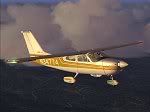 DreamFleet's Cardinal soon became my favorite aircraft in the simulator, and I found that it whetted my appetite for the real thing while preparing me for the experience of owning and operating my own Cardinal. After finding the real Yellowbird, I still used the simulator to practice cross country navigation, and to keep the flying bug happy on days when the weather kept Yellowbird and I on the ground. I suspect that Yellowbird may have gotten jealous of my divided attentions, so with plenty of weather-induced downtime this winter, I set about creating, in virtual form, what I knew in real life. I fired up Adobe Photoshop, and with a set of detail photos of the real thing, I set about giving life to Virtual Yellowbird.
DreamFleet's Cardinal soon became my favorite aircraft in the simulator, and I found that it whetted my appetite for the real thing while preparing me for the experience of owning and operating my own Cardinal. After finding the real Yellowbird, I still used the simulator to practice cross country navigation, and to keep the flying bug happy on days when the weather kept Yellowbird and I on the ground. I suspect that Yellowbird may have gotten jealous of my divided attentions, so with plenty of weather-induced downtime this winter, I set about creating, in virtual form, what I knew in real life. I fired up Adobe Photoshop, and with a set of detail photos of the real thing, I set about giving life to Virtual Yellowbird.
 Here she is, on a left downwind for 20 at Westfield. The virtual model displays the standard 1974 factory paint scheme in the colors of Tiger Yellow and Summer Gold over Vestal White. DreamFleet provides a good basic template in Photoshop PSD format, with the base color and various details drawn as separate layers. This makes it easy to add the paint scheme, and any additional details using more layers, provided you know how to draw in Photoshop. The fuselage is split into two pieces at the cabin/tailcone joint, so aligning stripes that run the full length of the fuselage can be tricky. It took several attempts to get it right. The airport scenery is a custom reworking of the default Westfield airport using Project AI AFCAD to update the runways, taxiways, and ramp areas, and Flight Simulator Scenery Creator to add the hangars and other buildings, but that's a story for another time.
Here she is, on a left downwind for 20 at Westfield. The virtual model displays the standard 1974 factory paint scheme in the colors of Tiger Yellow and Summer Gold over Vestal White. DreamFleet provides a good basic template in Photoshop PSD format, with the base color and various details drawn as separate layers. This makes it easy to add the paint scheme, and any additional details using more layers, provided you know how to draw in Photoshop. The fuselage is split into two pieces at the cabin/tailcone joint, so aligning stripes that run the full length of the fuselage can be tricky. It took several attempts to get it right. The airport scenery is a custom reworking of the default Westfield airport using Project AI AFCAD to update the runways, taxiways, and ramp areas, and Flight Simulator Scenery Creator to add the hangars and other buildings, but that's a story for another time.
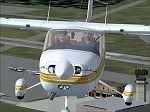 A front view shows off some of the few problems with the DreamFleet model. Most noticeable is the flat spot on the nose. It's roughly the size and shape of the larger intake areas of the '68 and '69 Cardinals, but the 3D model only depicts the "D" shaped intakes of the 177B, so you couldn't really do an early Cardinal. The texture details for the engine inside the intakes are quite convincing, but the intakes themselves are a little undersized. Also, to my eye, the landing lights are too high on the lower cowl, but this is only noticeable because I moved the cowl/nosebowl seam back a little. The ugly goofus in the pilot's seat is yours truly, thanks to some careful editing of the pilot textures. Faithful Instructor George rides along in the right seat.
A front view shows off some of the few problems with the DreamFleet model. Most noticeable is the flat spot on the nose. It's roughly the size and shape of the larger intake areas of the '68 and '69 Cardinals, but the 3D model only depicts the "D" shaped intakes of the 177B, so you couldn't really do an early Cardinal. The texture details for the engine inside the intakes are quite convincing, but the intakes themselves are a little undersized. Also, to my eye, the landing lights are too high on the lower cowl, but this is only noticeable because I moved the cowl/nosebowl seam back a little. The ugly goofus in the pilot's seat is yours truly, thanks to some careful editing of the pilot textures. Faithful Instructor George rides along in the right seat.
 A close-up on the ramp shows off some of the added details that were not included in the DreamFleet template. These include the static ports on the forward fuselage sides, the avionics cooling air intake on the right forward fuselage, the upper door hinges, and the lower windshield retainer strip. Due to the way the wing textures wrap around the leading edge, DreamFleet found it easier to paint the fresh air intakes and the stall warning port on the upper wing textures, which places them above the leading edge on the 3d model. I moved them to the lower wing, which puts them in the correct place at the cost of a small loss in visual clarity. The McCauley logo on the propeller is from a photo of the real thing.
A close-up on the ramp shows off some of the added details that were not included in the DreamFleet template. These include the static ports on the forward fuselage sides, the avionics cooling air intake on the right forward fuselage, the upper door hinges, and the lower windshield retainer strip. Due to the way the wing textures wrap around the leading edge, DreamFleet found it easier to paint the fresh air intakes and the stall warning port on the upper wing textures, which places them above the leading edge on the 3d model. I moved them to the lower wing, which puts them in the correct place at the cost of a small loss in visual clarity. The McCauley logo on the propeller is from a photo of the real thing.
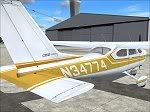 The tail features more added detail, including various panel lines and rivets on the tailcone, the two circular inspection plates forward of the stabilator, and the pull-out handles on the sides of the tailcone. The registration number, the fin flash and Cessna Cardinal logo on the fin, and the stylish curves in the paint scheme aft of the rear quarter windows were all taken from photos of the real Yellowbird. For all the work I put in, not all details could be changed. The antennas and late model wheel pants are defined by the 3D model, so they couldn't be changed to match Yellowbird's actual configuration. The interior colors were also left as they were, although I may consider repainting them someday. And finally, the avionics are from the default setup. Yellowbird's actual suite is similar, if not as complete as what DreamFleet gives you. I would rather upgrade her avionics to match the simulator, if the budget ever allows it!
The tail features more added detail, including various panel lines and rivets on the tailcone, the two circular inspection plates forward of the stabilator, and the pull-out handles on the sides of the tailcone. The registration number, the fin flash and Cessna Cardinal logo on the fin, and the stylish curves in the paint scheme aft of the rear quarter windows were all taken from photos of the real Yellowbird. For all the work I put in, not all details could be changed. The antennas and late model wheel pants are defined by the 3D model, so they couldn't be changed to match Yellowbird's actual configuration. The interior colors were also left as they were, although I may consider repainting them someday. And finally, the avionics are from the default setup. Yellowbird's actual suite is similar, if not as complete as what DreamFleet gives you. I would rather upgrade her avionics to match the simulator, if the budget ever allows it!
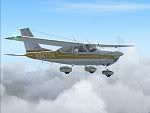 As for you, dear reader, if your budget allows for a few minutes of download time, you can fly away in a Yellowbird of your own. If you have a decent computer running either Microsoft Flight simulator 2002 or 2004, all you need to do is purchase the DreamFleet Cardinal and download my freeware Yellowbird texture files. They are zipped into an archive file that contains the main visual textures (N34774.bmp) and the alpha channel bitmap file (N34774_a.bmp) used to set the reflectivity of the exterior paint. Step by step instructions are included for using the Text-o-Matic utility to import these textures. As an added bonus, you also get a texture file to replace the stock pilot faces with my own mug and that of my instructor.
As for you, dear reader, if your budget allows for a few minutes of download time, you can fly away in a Yellowbird of your own. If you have a decent computer running either Microsoft Flight simulator 2002 or 2004, all you need to do is purchase the DreamFleet Cardinal and download my freeware Yellowbird texture files. They are zipped into an archive file that contains the main visual textures (N34774.bmp) and the alpha channel bitmap file (N34774_a.bmp) used to set the reflectivity of the exterior paint. Step by step instructions are included for using the Text-o-Matic utility to import these textures. As an added bonus, you also get a texture file to replace the stock pilot faces with my own mug and that of my instructor.
The ZIP file is available through the file libraries of AVSIM Online and FlightSim.com, two popular websites providing resources for the flight simulator community. (A free membership is required to access the file libraries.) The ZIP file (n34774.zip) is about 6 megabytes, so plan on a few minutes download time if you have a slow connection. Once you have downloaded the file, you can be airborne in a matter of minutes.
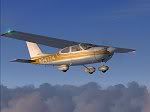 Cruising high above the clouds on a summer evening, Virtual Yellowbird shows off the lines that have made the Cardinal a classic, both in real form from Cessna, and in digital form as the flight simulator model from DreamFleet. If you enjoy this repaint let me know. And if you can, send me some screenshots of the adventures you have with your Virtual Yellowbird - I'll post them here for everyone to enjoy.
Cruising high above the clouds on a summer evening, Virtual Yellowbird shows off the lines that have made the Cardinal a classic, both in real form from Cessna, and in digital form as the flight simulator model from DreamFleet. If you enjoy this repaint let me know. And if you can, send me some screenshots of the adventures you have with your Virtual Yellowbird - I'll post them here for everyone to enjoy.
 Update: Picking up where I left off, Wayne Sinker has adapted my textures to model N34672, Cessna's photo subject for the 1974 sales brochure. He has even gone the extra mile and duplicated the brochure's cover. His freeware texture files ( n34672.zip) are available for download on AVSIM.com and FlightSim.com. Nice job, Wayne!
Update: Picking up where I left off, Wayne Sinker has adapted my textures to model N34672, Cessna's photo subject for the 1974 sales brochure. He has even gone the extra mile and duplicated the brochure's cover. His freeware texture files ( n34672.zip) are available for download on AVSIM.com and FlightSim.com. Nice job, Wayne!

Nice comments on Dreamfleets cardinal.I like your diary about Yellowbird and drop in quite often.Am downloading yellowbird so i to can enjoy your bird.Im a virtual pilot and only fly the cardinal.If i could fly then this would be the bird for me.Please keep up the diary,i find it very interesting.
Take Care
Best rgds
Les